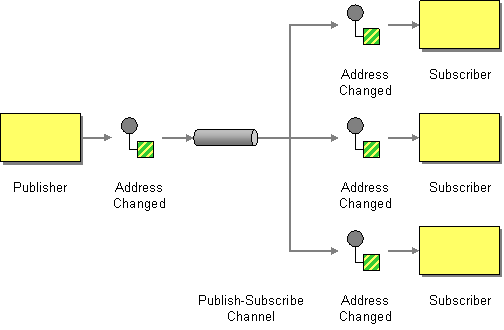5.2. Publish-Subscribe Channel
Overview
Copy linkLink copied to clipboard!
A publish-subscribe channel, shown in Figure 5.2, “Publish Subscribe Channel Pattern”, is a message channel that enables multiple subscribers to consume any given message. This is in contrast with a point-to-point channel. Publish-subscribe channels are frequently used as a means of broadcasting events or notifications to multiple subscribers.
Figure 5.2. Publish Subscribe Channel Pattern
Components that support publish-subscribe channel
Copy linkLink copied to clipboard!
The following Apache Camel components support the publish-subscribe channel pattern:
JMS
Copy linkLink copied to clipboard!
In JMS, a publish-subscribe channel is represented by a topic. For example, you can specify the endpoint URI for a JMS topic called
StockQuotes as follows:
jms:topic:StockQuotes
jms:topic:StockQuotesActiveMQ
Copy linkLink copied to clipboard!
In ActiveMQ, a publish-subscribe channel is represented by a topic. For example, you can specify the endpoint URI for an ActiveMQ topic called
StockQuotes, as follows:
activemq:topic:StockQuotes
activemq:topic:StockQuotesXMPP
Copy linkLink copied to clipboard!
Static subscription lists
Copy linkLink copied to clipboard!
If you prefer, you can also implement publish-subscribe logic within the Apache Camel application itself. A simple approach is to define a static subscription list, where the target endpoints are all explicitly listed at the end of the route. However, this approach is not as flexible as a JMS or ActiveMQ topic.
Java DSL example
Copy linkLink copied to clipboard!
The following Java DSL example shows how to simulate a publish-subscribe channel with a single publisher,
seda:a, and three subscribers, seda:b, seda:c, and seda:d:
from("seda:a").to("seda:b", "seda:c", "seda:d");
from("seda:a").to("seda:b", "seda:c", "seda:d");Note
This only works for the InOnly message exchange pattern.
XML configuration example
Copy linkLink copied to clipboard!
The following example shows how to configure the same route in XML:
